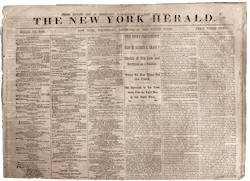February 25, 1863, The New York Herald
The most important news from the Southwest today is the reported capture of the Union ram Queen of the West, whose gallant exploits in running the blockade at Vicksburg are already known to our readers. She is said to have been captured under Fort Taylor, at Gordon’s Landing, on the Red river – the pilot, who was taken off the rebel steamer Eva, having treacherously ran her within range of the guns while asserting that the fort was fifteen miles away. Her steam pipe was knocked off, and she was otherwise so disabled that she drifted to the opposite shore, and all of the crew except thirteen escaped. The boat and the rest of the hands fell into the power of the rebels. The rebel official reports and the comments of the Southern journals upon the affair are published in another column.
Reports from Louisville yesterday described the invasion of Kentucky by the rebels as being of a very extensive and alarming character. They were said to be threatening Lexington, Frankfort, Danville and even Louisville itself. Gen. Longstreet was reported to be in command. These rumors, however, are denied by some of the Louisville journals. No facts concerning them have reached the headquarters of the Union army, and the latest despatches pronounce them absolutely false.
The rebel papers are compelled to admit that the story of breaking the blockade at Charleston was a gross exaggeration. The Weekly Enquirer, of Richmond, for example, says that […..] Southern confederacy has lately been made the dupe of a notable imposition. It was said, printed, echoed and reverberated over the land that on a certain night our two iron-clad vessels at Charleston had sunk two, disabled one and disposed of the rest of the blockading squadron off Charleston harbor. Now we learn with pain and certainty that no ship was sunk, none disabled and no damage, in short, was done to the blockading squadron, which, consisting of wooden ships only, avoided a fight with our iron-clads, and most judiciously, until they brought up iron-clads of their own, which they immediately did.”
The story which reaches us from Europe relative to the presence of a rebel privateer scouring the waters of the Indian Ocean is manifestly a canard. It resolves itself into the simple fact, as related by the Calcutta Englishman, that the bark Selim, Captain Simpson, inward bound from Melbourne, saw off Keeling’s Island, near the Straits of Sunda, to the southward of the equinoctial line, a large black man-of-war steamer lying to under three topsails, jib and spanker (no steam up, but funnel shut up as a telescope). When she sighted the Selim she bore away for her under all canvas, and when sufficiently near to make out the English flag rounded to again under small canvas, and showed what the captain of the Selim says has been described to him as, and which he had no doubt of being, the Confederate flag. This is about the entire story.
